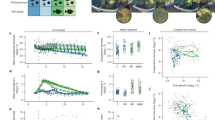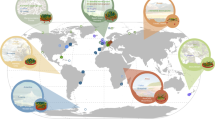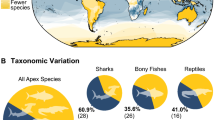Abstract
One of the twenty-first century’s greatest environmental challenges is to recover and restore species, habitats and ecosystems. The decision about how to initiate restoration is best-informed by an understanding of the linkages between ecosystem components and, given these linkages, an appreciation of the consequences of choosing to recover one ecosystem component before another. However, it remains difficult to predict how the sequence of species’ recoveries within food webs influences the speed and trajectory of restoration, and what that means for human well-being. Here, we develop theory to consider the ecological and social implications of synchronous versus sequential (species-by-species) recovery in the context of exploited food webs. A dynamical systems model demonstrates that synchronous recovery of predators and prey is almost always more efficient than sequential recovery. Compared with sequential recovery, synchronous recovery can be twice as fast and produce transient fluctuations of much lower amplitude. A predator-first strategy is particularly slow because it counterproductively suppresses prey recovery. An analysis of real-world predator–prey recoveries shows that synchronous and sequential recoveries are similarly common, suggesting that current practices are not ideal. We highlight policy tools that can facilitate swift and steady recovery of ecosystem structure, function and associated services.
This is a preview of subscription content, access via your institution
Access options
Access Nature and 54 other Nature Portfolio journals
Get Nature+, our best-value online-access subscription
$29.99 / 30 days
cancel any time
Subscribe to this journal
Receive 12 digital issues and online access to articles
$119.00 per year
only $9.92 per issue
Buy this article
- Purchase on Springer Link
- Instant access to full article PDF
Prices may be subject to local taxes which are calculated during checkout



Similar content being viewed by others
References
Burrows, M. T. et al. The pace of shifting climate in marine and terrestrial ecosystems. Science 334, 652–655 (2011).
Loarie, S. R. et al. The velocity of climate change. Nature 462, 1052–1055 (2009).
Corlett, R. T. Restoration, reintroduction, and rewilding in a changing world. Trends Ecol. Evol. 31, 453–462 (2016).
Neeson, T. M. et al. Enhancing ecosystem restoration efficiency through spatial and temporal coordination. Proc. Natl Acad. Sci. USA 112, 6236–6241 (2015).
Wolkovich, E. M., Cook, B. I., McLauchlan, K. K. & Davies, T. J. Temporal ecology in the Anthropocene. Ecol. Lett. 17, 1365–1379 (2014).
Suding, K. et al. Committing to ecological restoration. Science 348, 638–640 (2015).
Costello, C. et al. Global fishery prospects under contrasting management regimes. Proc. Natl Acad. Sci. USA 113, 5125–5129 (2016).
Jones, H. P. & Schmitz, O. J. Rapid recovery of damaged ecosystems. PLoS ONE 4, e5653 (2009).
Palmer, M. A. & Ruhl, J. Aligning restoration science and the law to sustain ecological infrastructure for the future. Front. Ecol. Environ. 13, 512–519 (2015).
Perring, M. P. et al. Advances in restoration ecology: rising to the challenges of the coming decades. Ecosphere 6, art131 (2015).
Estes, J. A. et al. Trophic downgrading of planet Earth. Science 333, 301–306 (2011).
Pauly, D., Christensen, V., Dalsgaard, J., Froese, R. & Torres F. Jr Fishing down marine food webs. Science 279, 860–863 (1998).
Sethi, S. A., Branch, T. A. & Watson, R. Global fishery development patterns are driven by profit but not trophic level. Proc. Natl Acad. Sci. USA 107, 12163–12167 (2010).
Ripple, W. J. et al. Status and ecological effects of the world’s largest carnivores. Science 343, 1241484 (2014).
Suding, K. N. Toward an era of restoration in ecology: successes, failures, and opportunities ahead. Annu. Rev. Ecol. Evol. Syst. 42, 465–487 (2011).
Wilen, J. & Brown, G. Jr Optimal recovery paths for perturbations of trophic level bioeconomic systems. J. Environ. Econ. Manag. 13, 225–234 (1986).
Andersen, K. H. & Rice, J. C. Direct and indirect community effects of rebuilding plans. ICES J. Mar. Sci. 67, 1980–1988 (2010).
Frank, K. T., Petrie, B., Fisher, J. A. D. & Leggett, W. C. Transient dynamics of an altered large marine ecosystem. Nature 477, 86–89 (2011).
Brown, C. J., Abdullah, S. & Mumby, P. J. Minimizing the short-term impacts of marine reserves on fisheries while meeting long-term goals for recovery. Conserv. Lett. 8, 180–189 (2015).
Sinclair, A. R. E. et al. Predicting effects of predation on conservation of endangered prey. Conserv. Biol. 12, 564–575 (1998).
Holt, R. D., Lawton, J. H., Polis, G. A. & Martinez, N. D. Trophic rank and the species–area relationship. Ecology 80, 1495–1504 (1999).
Harvey, C. J., Gross, K., Simon, V. H. & Hastie, J. Trophic and fishery interactions between Pacific hake and rockfish: effect on rockfish population rebuilding times. Mar. Ecol. Prog. Ser. 365, 165–176 (2008).
McCallum, H. Population Parameters: Estimation for Ecological Models (John Wiley & Sons, 2008).
Neubauer, P., Jensen, O. P., Hutchings, J. A. & Baum, J. K. Resilience and recovery of overexploited marine populations. Science 340, 347–349 (2013).
Kellner, J. B., Sanchirico, J. N., Hastings, A. & Mumby, P. J. Optimizing for multiple species and multiple values: tradeoffs inherent in ecosystem-based fisheries management. Conserv. Lett. 4, 21–30 (2010).
Costello, C., Kinlan, B. P., Lester, S. E. & Gaines, S. D. The Economic Value of Rebuilding Fisheries (Organisation for Economic Co-operation and Development, 2012).
Oken, K. L. & Essington, T. E. Evaluating the effect of a selective piscivore fishery on rockfish recovery within marine protected areas. ICES J. Mar. Sci. J. Cons. 73, 2267–2277 (2016).
Woods, P. J., Bouchard, C., Holland, D. S., Punt, A. E. & Marteinsdóttir, G. Catch-quota balancing mechanisms in the Icelandic multi-species demersal fishery: Are all species equal? Mar. Policy 55, 1–10 (2015).
Magnuson-Stevens Act Provisions; National Standard Guidelines. 81 FR 71858 (NMFS, 2016).https://www.federalregister.gov/documents/2016/10/18/2016-24500/magnuson-stevens-act-provisions-national-standard-guidelines
NRC Evaluating the Effectiveness of Fish Stock Rebuilding Plans in the United States (National Academies Press, 2014).
Bergstrom, B. J. et al. License to kill: reforming federal wildlife control to restore biodiversity and ecosystem function. Conserv. Lett. 7, 131–142 (2014).
Stier, A. C. et al. Ecosystem context and historical contingency in apex predator recoveries. Sci. Adv. 2, e1501769 (2016).
Branton, M. & Richardson, J. S. Assessing the value of the umbrella-species concept for conservation planning with meta-analysis. Conserv. Biol. 25, 9–20 (2010).
Svenning, J.-C. et al. Science for a wilder Anthropocene: synthesis and future directions for trophic rewilding research. Proc. Natl Acad. Sci. USA 113, 898–906 (2016).
Lester, S. E. et al. Biological effects within no-take marine reserves: a global synthesis. Mar. Ecol. Prog. Ser. 384, 33–46 (2009).
White, C., Costello, C., Kendall, B. E. & Brown, C. J. The value of coordinated management of interacting ecosystem services. Ecol. Lett. 15, 509–519 (2012).
Noonburg, E. G., Abrams, P. A., Losos, E. J. B. & DeAngelis, A. E. D. L. Transient dynamics limit the effectiveness of keystone predation in bringing about coexistence. Am. Nat. 165, 322–335 (2005).
McMeans, B. C., McCann, K. S., Humphries, M., Rooney, N. & Fisk, A. T. Food web structure in temporally-forced ecosystems. Trends Ecol. Evol. 30, 662–672 (2015).
Schrama, M., Berg, M. P. & Olff, H. Ecosystem assembly rules: the interplay of green and brown webs during salt marsh succession. Ecology 93, 2353–2364 (2012).
Hastings, A. Timescales, dynamics, and ecological understanding. Ecology 91, 3471–3480 (2010).
Holling, C. S. Resilience and stability of ecological systems. Annu. Rev. Ecol. Syst. 4, 1–23 (1973).
Pimm, S. L. & Lawton, J. H. Number of trophic levels in ecological communities. Nature 268, 329–331 (1977).
Neubert, M. G. & Caswell, H. Alternatives to resilience for measuring the responses of ecological systems to perturbations. Ecology 78, 653–665 (1997).
Reynolds, J. Conservation of Exploited Species (Cambridge Univ. Press, 2001).
Kellner, J. B., Litvin, S. Y., Hastings, A., Micheli, F. & Mumby, P. J. Disentangling trophic interactions inside a Caribbean marine reserve. Ecol. Appl. 20, 1979–1992 (2010).
Ricard, D., Minto, C., Jensen, O. P. & Baum, J. K. Examining the knowledge base and status of commercially exploited marine species with the RAM Legacy Stock Assessment Database. Fish Fish. 13, 380–398 (2012).
R Core Team. R: A language and environment for statistical computing (R Foundation for Statistical Computing, Vienna, Austria, 2014).
Packer, C. et al. Ecological change, group territoriality, and population dynamics in Serengeti lions. Science 307, 390–393 (2005).
COSEWIC COSEWIC Assessment and Status Report on the Steller Sea Lion Eumetopias jubatus in Canada (Committee on the Status of Endangered Wildlife in Canada 2013).
Cleary, J. S. Stock Assessment and Management Advice for British Columbia Pacific Herring: 2013 Status and 2014 Forecast (Department of Fisheries and Oceans Canada, 2014).
Holmengen, N., Lehre Seip. K., Boyce. M. & Stenseth, N. C. Predator–prey coupling: interaction between mink Mustela vison and muskrat Ondatra zibethicus across Canada. Oikos 118, 440–448 (2009).
Frid, A. & Marliave, J. Predatory fishes affect trophic cascades and apparent competition in temperate reefs. Biol. Lett. 6, 533–536 (2010).
Beaudreau, A. H. & Essington, T. E. Spatial, temporal, and ontogenetic patterns of predation on rockfishes by lingcod. Trans. Am. Fish. Soc. 136, 1438–1452 (2007).
Micheli, F., Halpern, B. S., Botsford, L. W. & Warner, R. R. Trajectories and correlates of community change in no-take marine reserves. Ecol. Appl. 14, 1709–1723 (2004).
Breen, P. A., Hilborn, R., Maunder, M. N. & Kim, S. W. Effects of alternative control rules on the conflict between a fishery and a threatened sea lion (Phocarctos hookeri). Can. J. Fish. Aquat. Sci. 60, 527–541 (2003).
Essington, T. E. et al. Catch shares, fisheries, and ecological stewardship: a comparative analysis of resource responses to a rights-based policy instrument. Conserv. Lett. 5,186–195 (2012).
Lambeck, R. J. Focal species: a multi-species umbrella for nature conservation. Conserv. Biol. 11, 849–856 (1997).
Roberge, J.-M. & Angelstam, P. Usefulness of the umbrella species concept as a conservation tool. Conserv. Biol. 18, 76–85 (2004).
Rodrigues, A. S., Pilgrim, J. D., Lamoreux, J. F., Hoffmann, M. & Brooks, T. M. The value of the IUCN Red List for conservation. Trends Ecol. Evol. 21, 71–76 (2006).
Evans, D. M. et al. Species recovery in the United States: increasing the effectiveness of the Endangered Species Act. Iss. Ecol. 20, 1–27 (2016).
Schwartz, M. W. The performance of the endangered species act. Annu. Rev. Ecol. Evol. Syst. 39, 279–299 (2008).
Magera, A. M., Flemming, J. E. M., Kaschner, K., Christensen, L. B. & Lotze, H. K. Recovery trends in marine mammal populations. PLoS ONE 8, e77908 (2013).
Yodzis, P . Must top predators be culled for the sake of fisheries? Trends Ecol. Evol. 16, 78–84 (2001).
Kutil, S. M. Scientific certainty thresholds in fisheries management: a response to a changing climate. Environ. Law 41, 233–275 (2011).
Cury, P. M. et al. Global seabird response to forage fish depletion—one-third for the birds. Science 334, 1703–1706 (2011).
Acknowledgements
T. Young helped to sharpen the presentation of this paper. J.F.S., A.C.S., B.S.H., and P.S.L. thank the Gordon and Betty Moore Foundation for their support of the Ocean Tipping Points project, J. Kellner for insightful comments about model dynamics, and Guujaaw for inspiration.
Author information
Authors and Affiliations
Contributions
J.F.S., A.C.S., P.S.L. and M.N. designed the study. J.F.S., A.C.S., M.N. and S.M.H. collected and analysed all data. J.F.S., A.C.S., P.S.L., B.S.H. and M.N. jointly wrote the manuscript.
Corresponding author
Ethics declarations
Competing interests
The authors declare no competing financial interests.
Supplementary information
Supplementary Information
Supplementary Discussion; Supplementary Figures 1–8; Supplementary Tables 1–3 (PDF 788 kb)
Rights and permissions
About this article
Cite this article
Samhouri, J., Stier, A., Hennessey, S. et al. Rapid and direct recoveries of predators and prey through synchronized ecosystem management. Nat Ecol Evol 1, 0068 (2017). https://doi.org/10.1038/s41559-016-0068
Received:
Accepted:
Published:
DOI: https://doi.org/10.1038/s41559-016-0068
This article is cited by
-
Synthesis of causal and surrogate models by non-equilibrium thermodynamics in biological systems
Scientific Reports (2024)
-
A multi-predator trophic database for the California Current Large Marine Ecosystem
Scientific Data (2023)
-
Availability of Alternative Prey Influences Avian Predation on Salmonids
Estuaries and Coasts (2022)
-
Competing tradeoffs between increasing marine mammal predation and fisheries harvest of Chinook salmon
Scientific Reports (2017)



